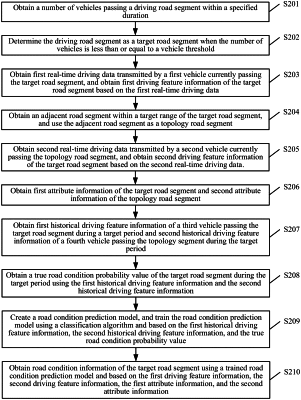| CPC G08G 1/0129 (2013.01) [G01C 21/3453 (2013.01); G06N 5/02 (2013.01); G08G 1/0112 (2013.01); G08G 1/052 (2013.01)] | 15 Claims |

|
1. A method for generating road-condition information by a first server, the method comprising:
obtaining a number of vehicles passing a driving road segment within a duration;
determining whether the driving road segment is a sparse road segment by determining whether the number of vehicles is less than or equal to a vehicle threshold, and
in response to determining the number of vehicles is less than or equal to the vehicle threshold, determining the driving road segment is the sparse road segment and then selecting the driving road segment as a target road segment, and
in response to determining the number of vehicles is greater than the vehicle threshold, determining the driving road segment is not the sparse road segment and then disregarding the driving road segment;
obtaining first real-time driving data transmitted by a first vehicle passing the target road segment, and obtaining first driving characteristic-information of the target road segment based on the first real-time driving data;
obtaining second real-time driving data transmitted by a second vehicle passing a topology road segment, and obtaining second driving characteristic-information of the target road segment based on the second real-time driving data, the topology road segment being a road segment within a target range of the target road segment;
sending an attribute information search request to a second server separate from the first server, the second server including a road segment management server;
receiving, from the second server, attribute information of the topology road segment generated by the road segment management server, wherein the attribute information of the topology road segment generated by the road segment management server includes a length of the topology road segment or a road grade of the topology road segment; and
generating road-condition information of the target road segment by inputting at least the second driving characteristic-information of the second vehicle on the topology road segment and the attribute information of the topology road segment to a trained road-condition prediction model,
wherein the road-condition prediction model is configured to output a congestion state of the target road segment and is trained by:
obtaining first historical driving characteristic-information of a third vehicle passing the target road segment during a target period and second historical driving characteristic-information of a fourth vehicle passing the topology road segment during the target period;
obtaining a true road-condition probability value of the target road segment during the target period using the first historical driving characteristic-information and the second historical driving characteristic-information, including: matching the first historical driving characteristic-information and the second historical driving characteristic-information with an offline driving characteristic-information to obtain a matching result, and filtering non-driving information in the matching result to generate the true road-condition probability value; and
training the road-condition prediction model using a classification algorithm and based on the first historical driving characteristic-information, the second historical driving characteristic-information, and the true road-condition probability value,
wherein the road-condition prediction model comprises a congestion prediction model configured to output a first road-condition probability value and a clearness prediction model configured to output a second road-condition probability value, and the congestion state of the target road segment is determined based on the first road-condition probability value and the second road-condition probability value.
|